A solar chimney is a renewable energy system used to enhance the natural ventilation in a building based on solar and wind energy. It is one of the most representative solar-assisted passive ventilation systems attached to the building envelope. It performs exceptionally in enhancing natural ventilation and improving thermal comfort under certain climate conditions. The ventilation enhancement of solar chimneys has been widely studied numerically and experimentally. The assessment of solar chimney systems based on buoyancy ventilation relies heavily on the natural environment, experimental environment, and performance prediction methods, bringing great difficulties to quantitative analysis and parameterization research. With the increase in volume and complexity of modern building structures, current studies of solar chimneys have not yet obtained a unified design strategy and corresponding guidance. Meanwhile, combining a solar chimney with other passive ventilation systems has attracted much attention. The solar chimney-based integrated passive-assisted ventilation systems prolong the service life of an independent system and strengthen the ventilation ability for indoor cooling and heating. However, the progress is still slow regarding expanded applications and related research of solar chimneys in large volume and multi-layer buildings, and contradictory conclusions appear due to the inherent complexity of the system.
- natural ventilation
- solar chimney
- Trombe wall
- renewable energy
- passive ventilation
- building application
1. Introduction to solar chimneys
Due to the potential benefits of passive ventilation systems in economic and energy conservation and resistance against noise and carbon dioxide emission[1-3], more research has focused on exploring and improving passive ventilation in the past 20 years. Passive ventilation strategies have been extensively studied over the years. According to local climate conditions and building characteristics, passive ventilation systems show different airflow characteristics and temperature distributions. Simultaneously, some passive ventilation systems also have heat dissipation and heat acquisition functions for space cooling and heating apart from providing adequate ventilation [3-9]. Most modern buildings rely entirely on mechanical ventilation, i.e., active ventilation systems, to satisfy indoor comfort. The majority of the energy supply is used for those active ventilation systems, occupying usable space due to its relatively large volume and structural complexity. Additionally, buildings with mechanical ventilation are often highly airtight to minimize energy consumption and heat loss, resulting in an inadequate fresh air supply [2].
Passive ventilation systems are increasingly being advocated as low-energy alternatives and low-cost solutions for energy conservation buildings. According to the pressure difference sources, typical modes of passive ventilation are referred to as wind-induced, buoyancy-driven, and hybrid ventilation [10,11]. Corresponding air movement is caused by wind pressure, temperature difference, or both of the above, and humidity difference [12]. It has been found that natural ventilation has the potential to provide adequate capacity for thermal regulation and satisfying indoor air quality in available climatic conditions without reliance on mechanical systems [10,13,14].
Passive ventilation systems rely on natural physical mechanisms, which make many uncertainties occur during operation. Wind-induced ventilation systems are solely dependent on prevailing wind speed and incident angle. The stochastics of wind direction and wind intensity bring significant challenges to system performance evaluation and design [15]. Buoyancy-driven ventilation builds upon the air intensity difference caused by the internal and external temperature difference, ventilating the space even in windless conditions. However, under extremely hot and humid climatic conditions (the temperature difference is insignificant), the system is probably not working properly. Not every passive ventilation system has the dual function of heating and cooling space driven by natural forces. The natural ventilation system can remove the stale warm airflow indoors by accelerating the air movement to provide a space cooling effect. Achieving heating usually requires collecting and storing heat gain and releasing heat when needed to increase the indoor temperature. As the most representative buoyancy ventilation system, the solar chimney has attracted researchers’ attention because of its simultaneous ventilation, heating, and cooling functions.
A typical solar chimney is presented in Figure 1. It consists of an absorption wall, a glazing wall, tuyeres/vents, and heat-insulating materials. Airflow is affected by the air density difference between the internal and external environment and the external wind [16-19]. Stale air escapes from the purpose-built openings by the thermo-siphoning effect. The solar chimney components can employ direct or indirect solar energy to drive the airflow in the space. Quesada et al. [20,21] comprehensively reviewed the research on transparent and translucent solar facades in the past ten years based on theory and experiment and explored its development and applicability. The solar façade absorbs and reflects incident solar radiation and converts direct or indirect solar energy into usable heat. Jiménez-Xamán et al. [22] verified that a roof-top solar chimney applied to a single room for cooling purposes could increase the ventilation rate by 1.16-45.0%. The numerical code was generated to solve the conjugate turbulent heat transfer in a single room equipped with a solar chimney based on the coupling of CFD and global energy balances.
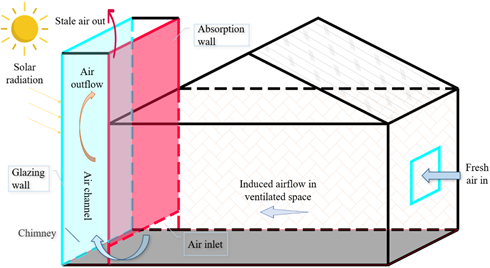
Figure 1. A schematic diagram of a solar chimney.
Solar chimneys stand out among many natural ventilation systems not only because of the convenience of their structural features when they are integrated into buildings or in conjunction with other ventilation systems but also because the solar chimney has heating and cooling modes through the cooperation of damping and openings, which makes the structure more sustainable. Figure 2 presents two modes that a solar chimney can achieve in the cooling season and heating season. In order to improve thermal comfort and enhance the applicability of natural ventilation, Monghasemi et al. [6] summarized the existing combined passive ventilation system based on solar chimneys and investigated the thermal regulation of the selected systems and their ability to improve ventilation efficiency.
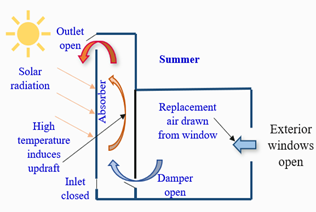 a
a
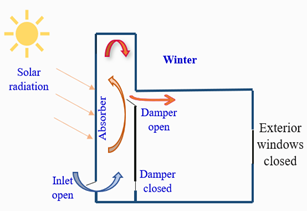
b
Figure 2. Schematic of solar chimney under heating and cooling modes: (a) cooling mode of a solar chimney; (b) heating mode of a solar chimney. Revised from [23]
2. Current research methods of the solar chimney
According to the review of Chen et al. [24,25], the existing Computer-Aided Prediction Models involve numerical models (usually assisted with CFD), analytical models, empirical models, full-scale or small-scale experimental models, multizone network models, and zonal models. A considerable part of the research on natural ventilation methods is based on experimental methods coupled with numerical simulations. Because of their complexity and the limitations of modeling methods, most previous studies are without detailed parametric analysis or merely focus on validating analytical models in corresponding experiments. According to the ref. [1], only 31% of the research used analytical methods, 10% of which used pure analytical methods, and the combination of analytical methods and experiments accounted for 13%. The remaining part used analytical methods combined with a numerical value. Based on simplified assumptions, different analytical models are capable of solving a series of energy-balance equations under specific scenarios, which in turn would limit the establishment of universal analytical models and solutions.
A prevailing method in passive ventilation uses computational fluid dynamics (CFD) to predict the air distribution and temperature distribution. Using CFD modeling can save time in simulating natural convection and predicting ventilation performance, allowing researchers to quickly develop optimal strategies for improving ventilation performance [26]. CFD can also analyze the multiple flow regimes caused by different driving forces (such as Laminar and turbulent) from an intuitive multi-dimensional perspective [27]. With the aids of CFD simulation, Kong et al. [28] determined the optimal inclination angles for the single-chamber roof solar chimney to achieve optimal ventilation performance. Sundar et al. [29] examined eighteen cases under different heat flux intensities and geometrical parameters with the aid of CFD and an experimental method for an inclined solar chimney. Nguyen and Wells [30] used CFD models to predict the ventilation rate and thermal efficiency of wall solar chimneys with four types of adjacent walls and different chimney configurations, and the heat source location. Salari et al. [31] developed a three-dimensional quasi-steady CFD model of a compound solar chimney with the photovoltaic module and phase change material and verified the three types of combined system performance.
With the aid of CFD-based computational methods, previous studies tried to find the optimal solution to enhance natural ventilation through geometric modification of the chimney configuration and the prediction of the flow pattern in the space connected to the solar chimney. The accuracy of CFD’s prediction of the performance of solar chimneys applied to natural ventilation in buildings has been widely recognized. Section 3 further discusses the influencing parameters of solar chimney performance in previous studies.
3. Influencing factors of solar chimney performance
Researchers have conducted many parametric studies to find the influencing parameters directly related to the ventilation rate. Shi et al. [32] summarised four groups of influencing factors (a total of thirteen influencing parameters) on solar chimney performance, including the configurations of solar chimney and buildings, installation methods, material properties, and the external environment. Changing the configuration parameters of the system is the most convenient and effective way, which has been reflected in many documents in detail, so this part is not presented in detail here. The influence of external environmental factors is usually related to solar radiation intensity and wind effect. With the continuous emergence of new materials, the properties of different materials also directly affect the performance of the solar chimney. The aggregated influencing factors are listed in Figure 3.
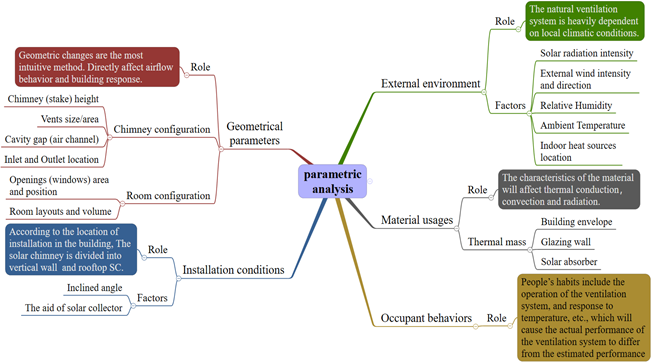
Figure 3. The influencing factors on the performance of the solar chimney.
The stack effect intensity is associated with aperture positions and the air density difference between inlet and outlet. Solar radiation intensity as one of the external environmental factors can result in a straight improvement in buoyancy-driven ventilation efficiency without considering the external wind effect. Menchaca-Brandan et al. [33] emphasized the importance of considering radiative effects in theoretical models or numerical simulations and experimental setup. The correct establishment of the radiation model will affect the accuracy of the prediction of ventilation efficiency and the accuracy of assessing the thermal comfort of indoor residents. Due to the buoyancy effect brought by the temperature difference, it is known that buoyancy-driven ventilation is preferable in temperate climates [34].
Excepting solar radiation, wind plays an equally critical role in influencing airflow patterns and thermal behavior. Some studies also compared the concurrent influences of solar radiance and external wind on the solar chimney system, and sometimes one driving force could be dominant under a particular condition. Additionally, the effect of wind factors on stack ventilation may be beneficial or unfavorable, depending on the pressure difference caused by the combination of wind pressure and air density difference at the air inlet, whether positive or negative. Shi et al. [35] investigated the interaction between solar chimney performance and external wind numerically and theoretically. When considering the influence of wind, the performance of solar chimneys depends not only on the wind speed but also on the incident angle. Based on the theoretical model developed, the critical wind speed was proposed. Wang et al. [36] verified that the dependence of solar chimney performance and airflow characteristics on solar radiation was reduced when the external wind was taken into account. It was found that keeping the vent size constant under the influence of wind, the optimal design value of the chimney cavity is 0.4–0.5 m, which is different from the previous optimal value of 0.2–0.3 m, which only considers the effect of buoyancy. Even at low wind speeds, solar chimney performance has been enhanced.
The coupling effect of the thermal mass and the buoyancy effect of naturally ventilated buildings has also attracted researchers’ attention. Yang and Guo [37] analyzed the non-linearity of the coupling effect between the thermal mass and the stack effect under an external heat source theoretically. The thermal behavior and ventilation rate fluctuations caused by coupling effects were discussed. Thermal-mass-integrated PCM provides an effective method of thermal storage [38]. Through the phase transition, combined with the thermal mass of PCM, naturally ventilated space maintains a relatively uniform temperature. It can significantly reduce the cooling load of the building in mild weather. Especially in the case of night ventilation, the role of PCM becomes more prominent [39,40]. Vargas-Lopez et al. [41] presented an extensive review of transient mathematical models based on global energy balance models of solar chimneys with/without PCMs. It is further developed the mathematical models for a double-channel solar chimney integrated with PCMs.
Figure 4 shows the controlling parameters used to evaluate the performance of passive ventilation systems. There are two main parameters used to evaluate and characterize the efficiency of passive ventilation systems from ventilation rate perspectives: air exchange efficiency and ventilation effectiveness [18]. Additionally, thermal efficiency is usually related to indoor temperature regulation and humidity control. For the specific values of each indicator, refer to ref. [42].

Figure 4. Indicators of performance.
Based on the analysis of the influence of control parameters, researchers have carried out extensive research on enhancing stand-alone solar chimney performance. The performance of the solar chimney can be significantly improved by selecting the optimal design parameters. Khanal and Lei pointed out [1] that previous studies related to solar chimneys aim to find optimum design solutions for enhancing natural ventilation, considering different design parameters. Most of the research is to optimize the system performance by changing the configuration of the solar chimney components and room openings from the geometric aspect. Enhancing natural ventilation will first consider changing the system’s configuration, mainly by changing the geometric parameters to determine the design parameters corresponding to the optimal ventilation efficiency [32]. Second, the sensitivity of system performance to external environmental parameters is considered to verify the applicable conditions of the system [17,32]. Thirdly, based on the analysis of the response, ventilation rate, and thermal behavior of the naturally ventilated building, the desired effect can be achieved by changing the system or building envelope materials, such as solar absorptance of the heat storage materials, heat transmittance, and solar reflectance of glazing cover [17,43]. Shi et al. [32] comprehensively summarized the correlation between different controlling parameters and solar chimney performance. The diversity of influencing parameters also brings variables to the design of solar chimneys according to local conditions. Zhang and Shi [44] clarified the optimal design value to improve the performance of the solar chimney by reviewing three factors: chimney configurations, installation conditions (chimney installation angle), and material properties.
In addition to geometrically changing the configuration parameters of the solar chimney and the ventilated room, recent studies have shown that some attempts to add components into the chimney cavity can also improve ventilation efficiency. Sheikhnejad et al. [45] employed a passive vortex generator (VG) in the air channel to enhance heat transfer. The effectiveness of this configuration improvement was successfully verified by using simulation technology. Among many studies on improving the heat storage capacity of absorption walls, it is worth mentioning that PCM integration into the solar chimney has been verified to affect ventilation rates and thermal comfort positively. By integrating PCM, a solar chimney can effectively store solar energy during the day and release heat at night, thereby improving the solar chimney performances and making the indoor temperature uniform [46]. Dordelly et al. [47] investigate the influence of integrating a PCM on the performance of two laboratory prototypes of solar chimneys and verified the effectiveness of integrating solar chimney and PCM to improve ventilation efficiency.
Most previous parameterization studies have been based on predicting ventilation rates and building response through geometric modifications. Critical considerations for improving natural ventilation performance include introducing different configurations, such as the inclination position of the roof-top solar chimney, window-to-wall ratio, cavity gaps, stack height, and orifices areas. In addition, there are some studies on the influence of thermal mass and the transmittance and reflectivity of glass materials on ventilation performance. Some parameter analysis also focuses on developing various mathematical models to examine the correlation between airflow or thermal performance and the design variables.
4. Works have been done at RMIT University, Australia
Figure 5 presents the contributions of RMIT University in the passive ventilation strategies over the years. Researchers at RMIT University have explained and presented a relationship between controlling parameters and ventilation capacity in buoyancy-driven ventilation. Referring to the parameterization studies on the various aspects mentioned in Section 2, researchers verified the influence of control parameters on the performance of independent solar chimneys and extended the solar chimney practice to the field of fire prevention and smoke control. Shi et al. [48,49] developed empirical models to predict the airflow rate through the air inlets under natural ventilation and smoke exhaustion. The effect of interaction mechanisms between the air inlet and the room window on the performance of the solar chimney was investigated.
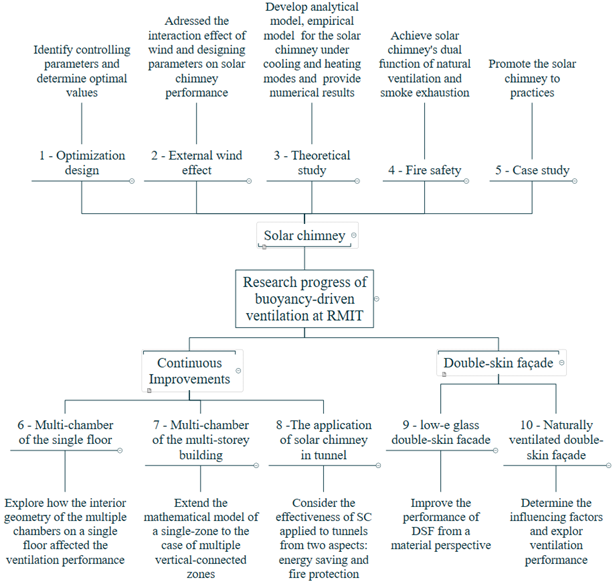
Figure 5. Research contributions on the solar chimney at RMIT University.
Additionally, Shi et al. [50] also promoted the practical application of solar chimneys, which laid the conditions for future field measurement. Cheng et al. [51] identified the factors that affect the natural ventilation efficiency and smoke suppression of a typical solar chimney. Regarding the dual functions of the solar chimney on energy conservation and fire safety, Shi et al. [50] developed a consistency coefficient to evaluate the correlation between controlling parameters and the solar chimney performance under the two modes in actual practice in Melbourne, Australia. The effectiveness of the solar chimney as a means of ventilation and smoke extraction was confirmed. Based on this actual project, Shi et al. [52] further conducted an optimization design of a solar chimney. Simultaneously, the realization of solar chimney ventilation and smoke exhaust in the tunnel is related to traffic safety and environmental impact. Cheng et al. [14] investigated four influential factors that govern solar chimney effectiveness in tunnel applications by developing a numerical model. Chimney height and the cavity gap become the dominant factors affecting the performance of solar chimneys in the two modes.
Through different research methods, Dr. Shi has made significant contributions to solar chimney research and promotion. Shi et al. [53] conducted the parametric analysis considering installation methods, room/chimney configuration, and cavity materials, thus developing the empirical models with the assistance of a fire dynamics simulator (FDS) to predict typical solar chimney performance. In another study, aiming at roof solar chimney, Shi et al. [54] not only summarized the previous mathematical models, the input parameters of testing ranges, and their experimental tests but also established the empirical models based on the experimental data of various general test rigs to predict the flow rate of roof-top solar chimneys and pointed out the configuration parameter values required to enhance ventilation rate. Shi et al. [55] developed theoretical models on heating and cooling modes of the wall solar chimney to predict the volumetric flow rate and temperature. Four solar chimney types were analyzed theoretically, considering room and chimney configurations and different fresh air supply methods. Consequently, the theoretical and experimental research on applying solar chimneys in single-chamber rooms tends to be consummated.
The emergence of the double-skin façade (DSF) with an air channel as one of the strategies for enhancing natural ventilation makes buoyant ventilation cater more to modern buildings’ functional and aesthetic needs due to its excellent acoustic insulation, thermal insulation, and transparent appearance. Solar-assisted passive ventilation systems attached to the building envelope have similar operational mechanisms and structural composition. Using solar-assisted thermal convection and stack effects, the buoyant airflows moving through the openable channels interconnected flow paths can ventilate the occupant spaces. Tao et al. [56] explored the correlation between the airflow behavior of the double-layer façade and the room configuration, coupled with the environmental factor on buoyancy-driven natural ventilation, by adopting experimentally validated numerical models. It revealed the best cavity gap and exhaust port height based on the simulation results and found the influence of the room window’s size and position on the ventilation rate. The numerical analysis of the naturally ventilated double-skin façade (NVDSF) confirmed the ability of NVDSF to induce indoor airflow and its energy-saving potential. Tao et al. [57] proposed a low-emissivity glass double-skin façade to reduce the indoor heating demand, considering solar radiation and natural convection. Additionally, the study also obtained the optimal air channel value of 0.15–0.3 m.
Research to improve natural ventilation mechanisms in sustainable buildings is ongoing. Researchers at RMIT used experiments, analysis, and simulation methods to conduct extensive research on thermosyphon air channels represented by solar chimneys with thermal buoyancy as the main driving force for air movement. The studies involve many considerations in designing the essential elements of solar chimneys and similar passive ventilation systems.
5. Potential trends and challenges of the solar chimney
The theoretical studies of solar chimneys in multiple chambers are scarce to support the view that it is feasible to use buoyancy ventilation in buildings with more rooms. Research on the application of independent solar chimneys in a single space has been extensively studied. However, with the increase in volume and structural complexity of modern buildings, the performance of solar chimneys in the multi-chamber is insufficient. The lack of theoretical research has led to the limitations of the solar chimney in the practical application of multi-chamber spaces. The studies on buoyancy-driven ventilation in a multi-chamber building can be divided into two types: the multi-chamber of the single floor and the multi-chamber of the multi-storey building. In recent years, only a few studies have involved the application of solar chimneys in multi-storey buildings. Punyasompun et al. [58] established a three-storey prototype building with a wall-integrated solar chimney and validated the analytical model by experimental data. The optimal structure of the multi-layer solar chimney is verified. That is, only one outlet is set at the top. It was found that the indoor temperature of a multi-story building using solar chimneys was 4–5 °C lower than that of a building without solar chimneys. By establishing an analytical model and conducting the numerical simulation, Yang and Li [59,60] compared the ventilation efficiency of a 10-story building prototype with/without a wall-integrated solar chimney with buoyancy ventilation and mixed ventilation mode and deduced a dimensionless expression and further determined the value of control parameters.
Moreover, the necessary conditions to ensure adequate natural ventilation include natural forces available, building characteristics, exterior envelope air infiltration and airtightness, and occupant behaviors [61-63]. Among them, the envelope’s properties with the most direct contact with the outside environment have become the leading research subjects. The coupling effect between the thermal mass of building envelopes and the stack effect has been projected from the improvement methods of the buoyancy-driven ventilation efficiency. However, such coupling effects studies are insufficient for the practice of solar chimneys in previous studies, whether through experimental verification or numerical simulation. Significantly, the practice of solar chimneys in conjunction with different building forms and climatic conditions requires sufficient case studies and theoretical guidance.
Although some studies draw attention to the attempts of combined systems over the years, parameterization research and theoretical analysis are far from enough to meet practical application needs. In a given environment, a coupling of multiple ventilation systems can compensate for each other’s performance and increase the service life of a single system. Figure 6 shows the independent passive systems combined with solar chimneys based on the selected literature review. Zhang et al. [42] categorized and reviewed the cross-application and combination potentials between independent natural ventilation systems. Compared to the conventional stand-alone passive ventilation system, considerably less research has been conducted on the dynamics and performance of multiple passive-assisted ventilation technologies in sustainable buildings. The study exhaustively recorded considerable attempts in natural ventilation in the past 20 years. Researchers mostly combined solar chimneys with other stand-alone systems and applied them to actual structures in the previous literature.
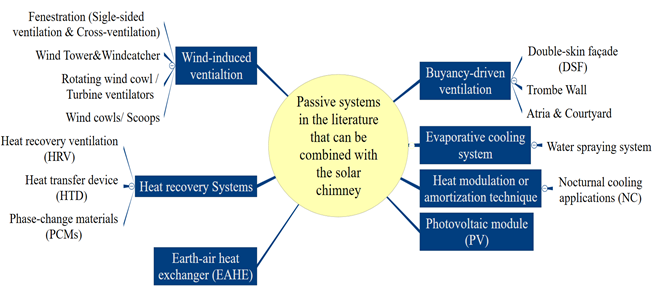
Figure 6. The coupling of passive systems and a solar chimney.
Based on structural superiority and economic and environmental benefits, the solar chimney has attracted growing interest as an excellent member of passive ventilation systems and advocated for as an auxiliary or alternative system for mechanical ventilation. The current research trend is more focused on combine PV modules with solar chimneys by coordinating components. Sivaram et al. [64] pointed out the commercial applicability of building-integrated passive solar energy technology in which photovoltaic modules and solar still are integrated into a single building configured with a solar chimney. The research of combined systems also shows diversification: the combination of multiple systems to maximize energy saving. Chandavar [65] explored the effectiveness of coupling the solar chimney and PV modules by field tests. As two self-sustained systems, the two components complement each other in their work, thus improving thermal efficiency. With the increasing demand for energy-saving, the combination of different ventilation systems is not only limited to double combinations, or triple combinations will get more attempts. Sakhri et al. [66] integrated a windcatcher, solar chimney, and earth-to-air heat exchanger into a test room and conducted a full-scale experiment. Ahmed et al. [13] suggested that a potential solution to combat the heatwaves in warm climates is a combination of a solar chimney, a windcatcher, and evaporative cooling. The related renewable energy systems that could be combined with a solar chimney are listed in Figure 6.
However, the passive ventilation system’s performance prediction depends on the local climatic conditions, the experimental settings, and the selection of the prediction method. Therefore, it is challenging and unpredictable to make quantitative comparisons between different passive ventilation combinations. In order to formulate the accessible strategy according to local conditions, not only indispensable theoretical support is needed, but also sufficient case analysis and experimental data are ensured for well-designed combinations, so as to determine the correlation and dependence between different controlling factors and weaken the unexpected correlation of different parameters.
6. Discussion and Conclusion
It is evident from extensive literature that a solar chimney is an excellent passive ventilation strategy used to enhance natural ventilation and provide thermal comfort. The effectiveness of the solar chimney on the improvement of ventilation rate and thermal regulation has been studied by various researchers numerically and experimentally. Table 1 summarizes the ventilation efficiency of independent solar chimneys and passive systems combined with a solar chimney. The indicators for characterizing ventilation efficiency have an extensive range of changes due to different study conditions, such as local climate, experimental settings, prediction tools, and design parameter selection (i.e., geometry modification of solar chimneys and adjacent spaces). It can also be seen from Table 1 that the combined system significantly improves temperature regulation and ventilation rate.
Table 1. The performance of a solar chimney and combined systems.
|
Performance |
Air temperature adjustment (°C) |
Volumetric/Mass flow rate (m3/s, m3/h, or kg/s) |
Air change per hour (ACH) |
Energy-saving percentage (%) |
Indoor relative humidity (%) |
|
Stand-alone Solar chimney |
Drop 1.0-5 ℃ [16,29,58,67-69]; 16.7 °C [70] |
50–374 m3/h [16,67,71]; 0.019–0.033 m3/s [72]; 0.55-44.44 kg/s [22,29,73]; 70.6 m3/h~1887.6 m3/h [74]; |
0.16-15 [22,67,68,71,75,76]; 27.11 [70]; 30 [77]; |
12–50% [74,78] |
|
|
Integrated systems based on solar chimneys |
Drop: 2.0-14℃ with water spaying [68,79]; 6.7-11.5 ℃ with evaporative cooling [80,81] [82,83]; 3.2–9 °C with EAHE [84,85]; 5.2℃ with windcatcher [86]; 10-13℃ with a windcatcher and EAHE [66]; 8℃ with a Trombe wall and water spraying system [87]; with ; Raises: 14℃ with Trombe wall and PV [88]; 6.4℃with EAHE [89]. |
1.4 kg/s with wind tower [90]; 0.0184 m3/s with EAHE [89]; 0.038-0.144 m3/s or 130.5 m3/h or 414 m3/h with evaporative cooling [80,82,83] |
35–73 with a wind tower [90]; 12 with PV [91]; 2.42-4.33 with evaporative cooling [81]; 9 with windcatcher [86] |
50% with a windcatcher and EAHE [66]; 75%-90% with windcatcher [86] |
Increases 17% with Trombe wall and water spraying system [87]; increases 28-45% [79] |
An increasing number of studies tend to combine multiple energy-saving systems with SCs with vertical or inclined thermosiphon air channels as an effective passive ventilation enhancement strategy. The strengths of solar chimneys come from providing the desired airflow rate economically, with a simple structure, less space requirement, and ease of integration into existing building facades. Although the research on the application of solar chimneys in single chambers has been going on for a long time, there is no unified theoretical basis and sufficient experimental results for its application in multi-story buildings. Additionally, the significant differences in the research results in the literature indicate that solar chimneys have not yet been thoroughly studied and developed. More theoretical support and experimental verification are needed to enhance the universality of solar chimneys to be popularized in practical applications. Simultaneously, previous research results have revealed the effectiveness of the multi-purpose application of solar chimneys (i.e., heating and cooling spaces, fire prevention, and smoke control), which also makes the research of solar chimneys very promising.
This article investigates the current development of solar chimneys used in buildings to enhance natural ventilation. The working mechanism and typical structure of solar chimneys are briefly presented. The influencing parameters related to ventilation efficiency, temperature distribution, air pattern, and IAQ have been confirmed. This article explores current research gaps of solar chimneys and the various possibilities for enhanced performance. It was observed that a stand-alone solar chimney used in a single room and ideal climatic conditions could effectively provide indoor thermal regulation and enhanced ventilation rate, while a combined system based on solar chimneys can cope with more diverse climatic conditions and provide buildings with functional energy-saving solutions. Previous research has focused on achieving the optimal design strategy based on parameter analysis, including geometrically improving the configuration of the ventilation system and the subsequent response analysis of adjacent spaces. Some of the research hotspots of buoyancy-driven ventilation systems represented by solar chimneys also include the impact of building opening positions on natural ventilation and the coupling effect of the building’s thermal mass on buoyancy-driven ventilation. However, since natural ventilation is heavily dependent on local climatic conditions and experimental settings under different working conditions, this brings challenges to quantitative analysis and parallel comparison of system performance. How to improve the stability of the system to cope with different climatic conditions and prolong the durability of the system has become a problem that needs to be solved. In addition, although there have been some attempts at hybrid natural ventilation, the practical application of passive-assisted ventilation systems in a building is limited due to the lack of a large amount of experimental and theoretical support for the coupling system. As the population continues to increase, it is not surprising that multiple rooms have natural ventilation scenarios. At present, only a small amount of research involves the application of solar chimneys in multi-chamber spaces, including single-story buildings with multi-chambers and multi-storey buildings. However, due to the increase in the amount of spaces, the dimensionality of the variables is undoubtedly increased, thereby increasing the difficulty of theoretical derivation. So far, there is no unified design guide for solar chimneys to enhance natural ventilation in multi-chamber scenarios.
